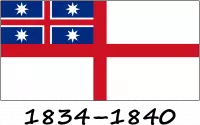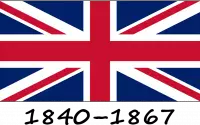The first flag of New Zealand dates back to 1834. The reason for the creation of the flag was an incident that occurred in 1830. A New Zealand merchant ship was detained in Sydney. The reason for this was that the vessel did not have an official flag, and therefore could not carry out international trade, as according to British law, every ship must fly the flag of its country. That is why the first flag of New Zealand was chosen on March 20, 1834, when British resident James Busby offered the Maori leaders (the indigenous people of New Zealand) flag options. James Busby (February 7, 1802 - July 15, 1871) was a British resident in New Zealand from 33 to 40 years old and is considered the first lawyer of the state and the founder of the Australian wine industry, as he brought the first collection of vines from Spain and France to Australia. Thus, the flag of the United Tribes of New Zealand became the first flag of New Zealand. The flag consisted of a red cross on a white background. In the upper left corner (canton) was a red cross on top of a white cross, which divided the canton into four blue squares, each with a white eight-pointed star. The red cross of St. George, a traditional symbol of England, reflected the connection with Great Britain. The blue color symbolized the sea that washes over New Zealand, and the eight-pointed stars represented the main Maori tribes that united under this flag. The adoption of this flag facilitated trade relations with other countries and ensured the safety of New Zealand ships.

The flag of the United Tribes of New Zealand was replaced by the British Union Jack, which was used until 1867. The Treaty of Waitangi (Te Tiriti o Waitangi), concluded in 1840 between the British Crown and more than 500 Maori representatives, became a fundamental document for New Zealand. This treaty ensured peace and a strong partnership between Maori and Pakeha. Pākeha is a name created by Maori to refer to the first European settlers of New Zealand, most often referring to the population of British descent. However, the treaty in the Maori language was different from the English version, which led to misunderstandings and disputes between the Maori and Pakeha. In addition, the British government was more interested in colonizing most of the territories than in fulfilling the terms of the treaty.

Despite the fact that many Maori did not sign the treaty and demanded that their rights be respected, the British government continued to expand its possessions. Gradually, New Zealand became a British colony, and this transition was not easy and was accompanied by conflicts and violence. Nevertheless, the treaty was recognized as the foundation of the modern legal and political system and remains a key document in New Zealand's history, playing an important role in the relationship between Maori and the government.

The New Zealand flag as we know it today officially became the national flag in 1902. However, it went through several iterations before its current design was approved. Initially, in 1867, a flag was adopted that featured a Union Jack on a blue field in the upper left corner and the letters "NZ" in the lower right corner. This design was intended to clearly identify New Zealand ships while maintaining a strong connection to the British Empire. In 1869, the flag was redesigned to replace "NZ" with the Southern Cross constellation, represented by four red stars with white borders to the right of the Union Jack. This change reflects New Zealand's unique geographic identity and its place in the southern hemisphere. The current design, which includes the Union Jack and Southern Cross, was officially adopted in 1902. In 2016, New Zealand citizens took part in a referendum on a possible change to the national flag. The proposed new design was intended to better reflect the country's independence and modern identity. However, the majority of voters decided to keep the current flag, appreciating its historical significance and symbolism.









